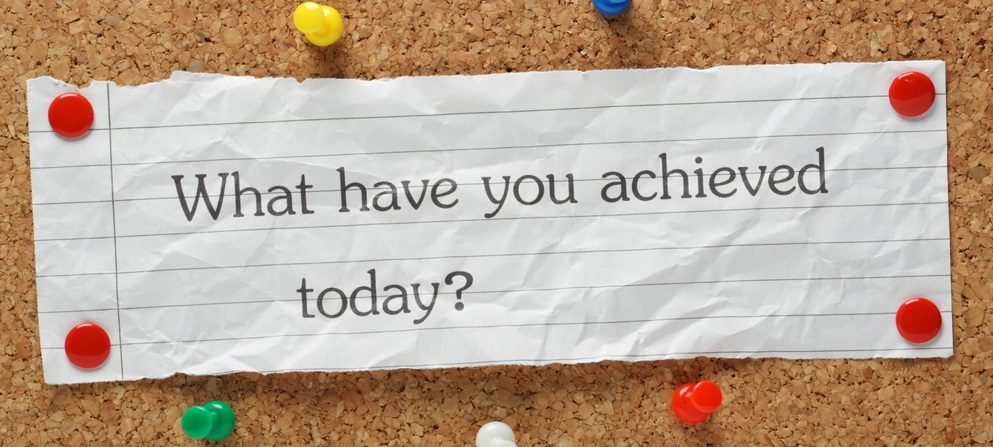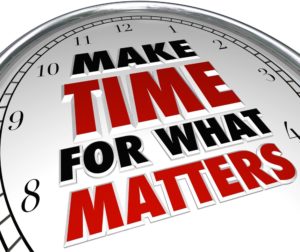 An important skill is to learn how to manage your time so all your commitments get taken care of daily. This is an important skill considering that you may be just too busy and your commitments get dropped. Or do you find that time seems to slip away and nothing gets done?
An important skill is to learn how to manage your time so all your commitments get taken care of daily. This is an important skill considering that you may be just too busy and your commitments get dropped. Or do you find that time seems to slip away and nothing gets done?
Most people think that time management is hard to learn when it comes to setting priorities. This does not have to be the case.
In fact, when you learn to manage your time, you will find that all the priorities get handled and you begin to realize that not everything is an emergency.
There are ways to organize yourself so that you manage all your tasks that need to be done and you may even find that you are able to finish them without feeling rushed or overwhelmed.
Wouldn’t that be a dream?
Stephen Covey’s The 7 Habits of Highly Effective People has some great ideas when it comes to time management. He has come up with a grid that is very effective.
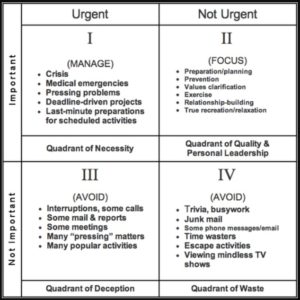
This grid provides an opportunity to look at each item you have to do and then decide on which part of the grid it belongs to.
Covey designed the grid using different colors reflecting how urgent or not urgent tasks are and where they belong on the grid.
Although this image of the grid does not show the colors he used, here is how you can get the idea of what he was trying to do with the grid.
- Purple needs to be done ASAP
- Green needs to be done but may need some planning or research
- Pink is for items that need to be done by others
- Light green is all the unimportant items that we often use to procrastinate (for example, watching TV).
The advantage of having this grid is that it is a great way to create a daily to-do list. You will then prioritize all the items you need to do with the idea of assigning importance or not.
You can use this grid by deciding what items you will take care of first. However, make sure that you don’t just do the urgent items as you might end up missing something that is important but not urgent.
How to Eliminate Urgency in Your Life
 When you focus on items you have assigned the green color to, you are able to reduce the amount of purple (urgent) items you have to deal with.
When you focus on items you have assigned the green color to, you are able to reduce the amount of purple (urgent) items you have to deal with.
When you say no to others asking for a commitment, you can eliminate any items assigned the pink color by getting others to do it for you.
The upside of this grid is that when you have control of your time and the items you need to take care of, you will eliminate anything assigned a light green color.
The reason? You won’t need to procrastinate anymore. Isn’t that a great idea?
How to Learn to Say No!
Do you remember that as a child you were corrected every time you said no! Unfortunately, as adults, we have a hard time saying no. Most women can relate to this!
Using the grid, you can determine whether you should say no or not to something.
If you have a request from a client that is only going to take a few minutes and is not really important, you might decide to still do it.
Also, if it’s something you really like doing, you can always do it once you have done the urgent tasks.
Evaluate Your Time Investments
 Now that you have the time management grid, you can take some take to re-evaluate all the items you have to take care of each day.
Now that you have the time management grid, you can take some take to re-evaluate all the items you have to take care of each day.
You can decide which ones are urgent and which ones are not.
Knowing what’s important to get done by you in a timely manner and items you can assign to someone else will help you prioritize your workload.
When you prioritize all you have to do each day, you will be able to carry this plan through in the months to come.
It is important to assess each task, decide where it needs to go on the grid, and then you will be able to just complete the tasks based on their priority.
Learning to use this grid system regularly, you will become more adept at how to manage your time, and that is a good thing!
How to Set a Schedule and Then Stick to It
 Most of us find it hard to follow a schedule when it comes to time management. This is particularly true for people who work for themselves.
Most of us find it hard to follow a schedule when it comes to time management. This is particularly true for people who work for themselves.
However, when we set a schedule to follow when we work for ourselves, it means that we have a better chance of being successful.
One of the best ways to get things done is to have your schedule written down. It makes it easier to see your tasks, but more importantly, you know what you need to get done.
Here are some ways to have your schedule easily available:
Use Your Cell Phone: our cell phones are really like little computers.
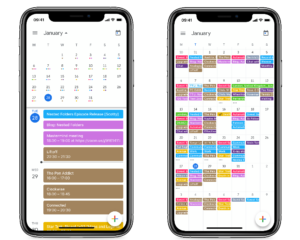 Most people have their entire life in the palm of their hand when it comes to using a cell phone.
Most people have their entire life in the palm of their hand when it comes to using a cell phone.
It comes with a notepad and calendar so you can easily track your schedule.
There are even reminders that you can use with alarms.
This is an easy way to keep you on track!
Use the Google Calendar: most people have a Google Gmail account.
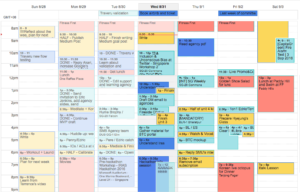 This is another powerful way to keep track of your schedule.
This is another powerful way to keep track of your schedule.
The other good thing about the Google Calendar is that you can access it from any of your devices.
Another way to use it is to have different calendars for different parts of your life.
You can even use color-coding. One last good thing about this, you can print it off or even sync it to your cell phone.
Now you don’t have any more excuses!
Use a Project Management System: there are a number of different project management systems available. These types of systems are good for people who like to outsource tasks to others.
They also can send emails to remind you as to when the task needs to be completed.
Use an Old Fashioned Day-Timer: this time of scheduler has been around for decades, long before any technology. Lots of people still use them.
The only downside is if you lose it, you have lost all the information on your appointments and tasks.
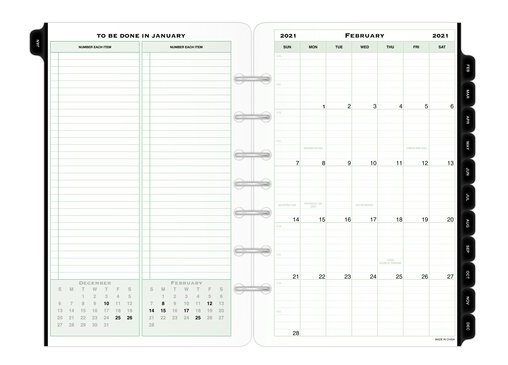
Use a Whiteboard: another choice that is perfect especially if you have a wall in your office where you can hang a whiteboard.
This way the tasks are front and center so you can’t miss what you need to do. You can also erase the tasks as you finish them. This is a great idea on how to manage your time.
Final Thoughts:
It is going to require a commitment on your part if you are going to set a schedule and then stick to it.
This doesn’t mean you can’t be flexible with your time. It just means that you can do what is required of you and saving less urgent tasks.
Being flexible means that if something comes up like a family emergency, you reschedule your tasks for another time.
When you write down your schedule of tasks that need to be taken care of, you are able to see what needs to be done.
The results are that you are better able to manage your time and as well improve your life. And that is a very good thing!
Learn how to use Stephen Covey’s Four Time Quadrants to Maximize Your Productivity Video:
